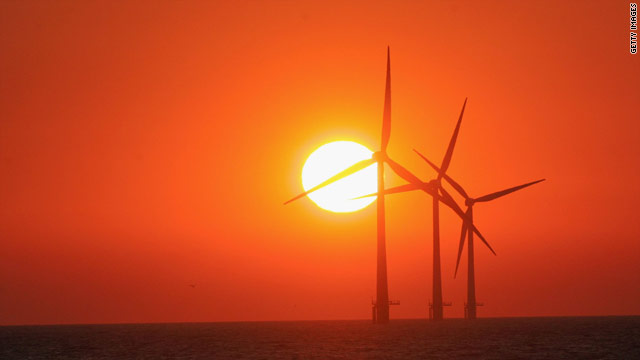Green energy market 'resilient' to downturn in 2009, according to U.N.

- Renewable energy investment still strong despite global recession, says U.N.
- Over half of all new electricity capacity created in 2009 came from renewable sources
- Wind power received record investment, with China performing strongly
London, England (CNN) -- The creation of new power capacity from renewable energy has exceeded new fossil fuel power generation in the United States and Europe for the second year running, according to two United Nations reports published Thursday.
Renewables accounted for over 50 percent of new capacity in the U.S. in 2009 while in Europe the figure was 60 percent, leading the U.N. to predict that the world as a whole will add more capacity to the electricity supply from renewables than non-renewables this year or by 2011.
Globally, nearly 80 giga-watts (GW) of new renewable power capacity was added in 2009, the U.N. reported.
U.N. Environmental Program (UNEP) executive director, Achim Steiner said in a statement that the story of renewable energy investment in 2009 was one of "resilience to the financial downturn," with many businesses and governments determined to "transform the financial and economic crisis into an opportunity for greener growth."
The two reports -- "Global Trends in Sustainable Energy Investment 2010" and "Renewables, 2010 Global Status" -- reveal that investment fell seven percent, from $173 billion in 2008 to $162 billion in 2009, largely due to declines in large-scale solar power and biofuels investment, which dropped 27 percent and 62 percent respectively.
But other green energy sub-sectors bucked the downward global investment trend.
Wind and biomass sectors both saw investment rise 14 percent, while energy smart technologies -- which include power storage and energy efficiency devices -- rose 34 percent to $4 billion.
"One of the upsides of the downturn of last year was that it did lead to a significant decease in the cost of some these [renewable] technologies, particularly in solar," Eric Usher, manager the UN's Sustainable Energy Finance Initiative, told CNN.
"So while investment numbers are flat or a little bit decreasing the actual scale of installation has been continuingly increasing."
--Julian Wong
According to the U.N., wind power received record investment in 2009 -- $67 billion in 2009 compared with $59 billion in 2008 -- with a total of 38 GW of new energy installed worldwide.
Over a third of this capacity was due to Chinese growth where 13.8 GW of wind power were added in 2009.
Julian Wong, a Chinese energy policy expert at the Washington-based think tank, the Center for American Progress, told CNN: "China is doing what no other country in the world is doing. China is an example of what can be done, with good, strong policy to develop a vibrant sector."
Wong says the Chinese domestic market is growing very quickly, with the government now targeting seven sites across the country which will be wind "megabases" generating 10-20 GW of power.
"I expect sometime this year, or early next, China will revise its targets on renewable energy upwards. This will provide a very strong signal to investors and provincial government that it is a priority for the country," Wong said.
China's renewable energy expansion is a "positive message globally," Eric Usher believes.
"But it's also a warning signal for western industries that they're very serious about this sector and the competition will be strong in the future," Usher said.
It's not just China where wind power is really taking off. The U.N. highlighted the growth of wind power in the North Sea off the UK.
"Things are shaping up extremely well for the UK wind energy sector," Nick Medic, head of communications at RenewableUK, the trade body for country's renewable wind and marine industries.
"We have a colossal 49 GW offshore at various stages of development which could supply around 40 percent of the UK's total electricity," Medic said.
Unlike its large-scale cousin, smaller solar photovoltaics (PV) panels received record investment in 2009 passing the $40 billion mark.
The U.N. says that grid-connected solar power had grown from 0.2 GW in 2000 to 21 GW by the end of 2009.
Europe and Asia/Oceania are the two powerhouses of investment according to the U.N., contributing nearly $85 billion (Europe $43.7 billion, Asia/Oceania $41 billion) of total green energy investments in 2009.
Asia/Oceania was the only region to see a significant increase in investment -- up nearly $10 billion from 2008. The Middle East and Africa saw a modest increase from $2.1 billion in 2008 to £2.5 billion in 2009.
"The fundamentals of the sector continue to be quite strong. The fact that you've seen a plateauing in investment rather than a large drop off in the last two years has signaled that the markets are in the longer term still poised for growth," Usher said.
More than 100 countries now have renewable energy policies or promotions in place -- nearly double the figure five years ago, according to the U.N.
Renewable energy now contributes a quarter of the world's electricity capacity and is responsible for 18 percent of global power production.
Michael Liebreich, chief executive of Bloomberg New Energy Finance said in a statement: "The relatively resilient performance of the sector during the current economic downturn shows that clean energy was not a bubble created by the late stages of the credit boom, but is instead an investment theme that will remain important for the years ahead."
